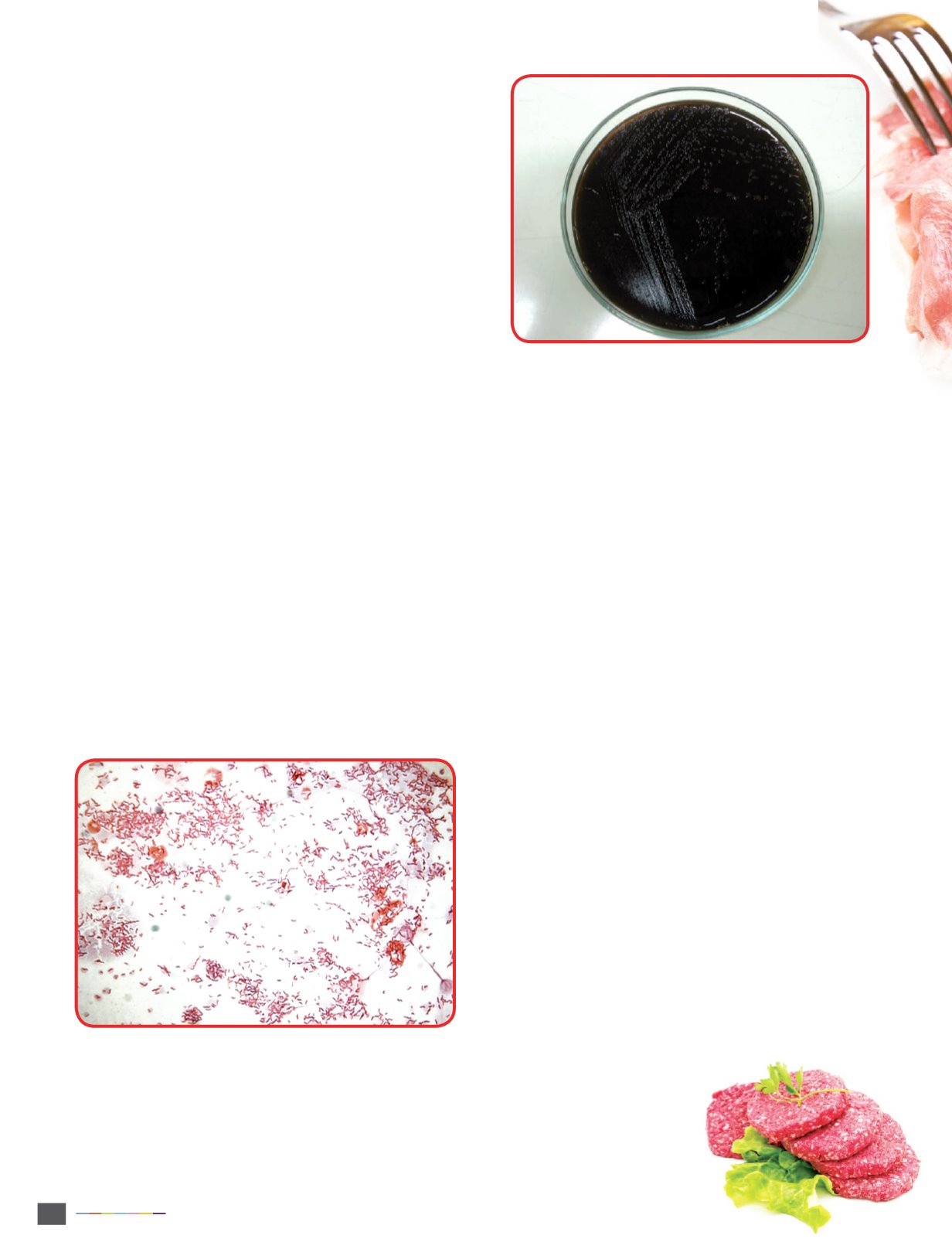
Food Focus Thailand
AUGUST 2013
40
การเพาะเลี้
ยงเชื้
อ
Campylobacter
spp.
บริ
สุ
ทธิ์
แบ
งออกเป
น 2 ขั้
นตอน คื
อ
1. การเพาะเลี้
ยงในอาหารเลี้
ยงเชื้
อชนิ
ดเหลว (Pre-enrichment)
เป
นขั้
นตอนการเพาะเชื้
อเพื่
อเพิ่
มจำนวนเชื้
อในอาหารเลี้
ยงเชื้
อ
ชนิ
ดเหลว โดยเชื้
อ
Campylobacter
spp. ที่
เก็
บแช
แข็
งไว
ในหลอดสต็
อกเชื้
อ
(Stock culture) จะถู
กนำมาเพาะเลี้
ยงในอาหารเหลว Brain heart
infusion โดยใช
ลู
ปฆ
าเชื้
อ (Sterile loop) เขี่
ยเชื้
อจากหลอดสต็
อกเชื้
อ
ใส
ลงในอาหารเหลว Brain heart infusion แกว
งเบาๆ ป
ดฝาพร
อม
คลายเกลี
ยวไว
หลวมๆ แล
วนำหลอดทั้
งหมดใส
ในภาชนะเลี้
ยงเชื้
อ
ในสภาวะไร
ออกซิ
เจน (Anaerobic jar) ที่
ใส
Gas pack สำหรั
บ
เพาะเชื้
อ
Campylobacter
sp. ป
ดฝาให
สนิ
ทแล
วนำไปบ
มที่
อุ
ณหภู
มิ
42°C
เป
นเวลา 48 ชั่
วโมง
2. การเพาะเลี้
ยงเชื้
อบนเพลทอาหารเลี้
ยงเชื้
อชนิ
ดแข็
ง
วิ
ธี
การนี้
เป
นการนำเชื้
อที่
บ
มได
แล
วจากหลอดอาหารเหลว Brain
heart infusion ในขั้
นตอนที่
1 มา Streak ลงบน Blood agar base
ที่
ผสม Leaked horse blood ร
อยละ 5 นำเพลทที่
Streak แล
วทั้
งหมด
ใส
ลงในภาชนะเลี้
ยงเชื้
อในสภาวะไร
ออกซิ
เจนที่
ใส
Gas pack เรี
ยบร
อย
แล
ว ป
ดฝาให
สนิ
ทแล
วนำไปบ
มที่
อุ
ณหภู
มิ
42°C เป
นเวลา 48 ชั่
วโมง
หลั
งจากนั้
นสั
งเกตและบั
นทึ
กลั
กษณะเฉพาะของโคโลนี
ของเชื้
อ
Campylobacter
spp. ซึ่
งจะมี
ขนาดเล็
กประมาณ 1.5 มิ
ลลิ
เมตร มี
สี
เทา
เยิ้
ม และมี
ความมั
นวาว (รู
ปที่
1) เมื่
อนำโคโลนี
ที่
ได
ไปย
อมแกรม
(Gram stain) และส
องดู
ด
วยกล
องจุ
ลทรรศน
เพื่
อเป
นการยื
นยั
นว
าเชื้
อ
ที่
เพาะเลี้
ยงได
คื
อเชื้
อ
Campylobacter
spp. จริ
ง โดยลั
กษณะเฉพาะของเชื้
อ
Campylobacter
spp. ติ
ดสี
แกรมลบ (Gram negative) และมี
รู
ปร
างเป
น
ท
อนโค
งหรื
อเป
นเกลี
ยว (รู
ปที่
2)
รู
ปที่
2
.
แสดงลั
กษณะรู
ปร
างของเชื้
อ
Campylobacter
spp. หลั
งจากย
อมแกรม
แล
วส
องดู
ด
วยกล
องจุ
ลทรรศน
เชื้
อ
Campylobacter
spp.
เป
นแบคที
เรี
ยชนิ
ดแกรมลบ เนื่
องจากย
อมติ
ดสี
แดงและมี
รู
ปร
าง
เป
นท
อน โค
ง หรื
อบิ
ดเป
นเกลี
ยว
Figure 2
The special feature of
Campylobacter
spp. is gram negative
bacteria which has the bacilli, curve or spiral shape.
รู
ปที่
1.
แสดงลั
กษณะโคโลนี
ของเชื้
อ
Campylobacter
spp. บนอาหารเลี้
ยงเชื้
อ
Blood agar base ที่
ผสม Leaked horse blood ร
อยละ 5
Figure 1
The appearance of the colony of
Campylobacter
spp. on blood
agar base with 5% leaked horse blood
The majority of them are children of the age 1-4 year old. As for in the
developing countries, including Thailand, the rate of sickness is 100
times higher than in the developed countries, and the rate of sickness
among tourists is at 2-3 percent per year. Among all diarrhea patients,
5 percent is caused by
Campylobacter
spp., and by
Salmonella
spp.
2-3 percent. In addition, there is interesting study of diarrhea in the
developed countries is more severe than in the developing countries,
as 50 percent of all patients have intestinal hemorrhage, compared
to 30 percent of such symptom found in Thailand. As for the study
on the contamination of
Campylobacter
spp. in meat products, the
contamination rate in chicken is 50-90 percent in the U.S. In Thailand
during the year 2000-2003, the study in the Northern provinces
showed that the contamination rate in chicken was 47 percent, and
33 percent in pork. Moreover, the contamination was found among
chicken and pig growing in the farms at the rate 64 percent and 61
percent, respectively. Presently, many researchers have conducted
and developed the assay methods for microbial agents to give the
result more quickly in order to control and eliminate the pathogen for
safety of consumers.
Campylobacter
spp. is the Gram-negative bacteria which has the
bacilli, curve or spiral shape. They can move by the use of flagella.
The culture of
Campylobacter
spp. requires the low oxygen condition,
around 3-6 percent, for their growth.
The Pure Culture Technique of
Campylobacter
spp.
is divided into two steps, which are
1. Pre-enrichment Broth Culture
It is themethod of multiplyingmicroorganism in the pre-enrichment
broth by recovering the stock cultures of
Campylobacter
spp. in
Brain heart infusion broth. The experimenter would use the cooled
sterile loop to inoculate
Campylobacter
spp. from stock cultures into
Brain heart infusion broth. They may
slightly shake and do not fitting close.
Incubate the culture in an anaerobic
jar with gas pack under 42
O
C for 48
hours.


